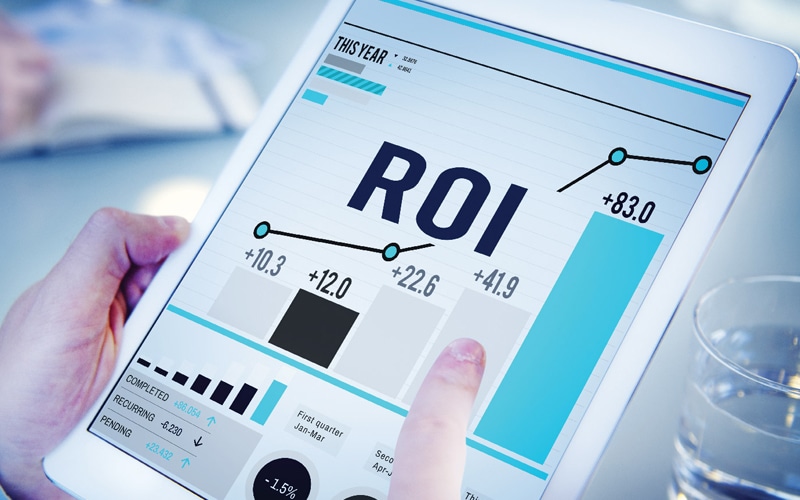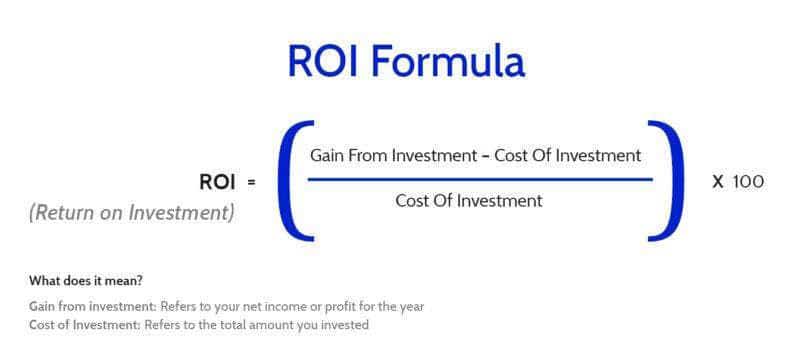What is Return on Investment?
Return on Investment or ROI is a financial ratio that you can use to evaluate the efficiency of an investment. Investors also use it for comparing the efficiency of multiple different investments. ROI tries to measure the amount of return on a specific investment directly, relative to the cost of the investment. To calculate ROI, you have to divide the return or the benefit of the investment by the cost of the investment. The result comes out as a ratio or a percentage.
You can calculate ROI by following this formula:
The current value of an investment is what an investor obtains from the sale of the investment of interest. As ROI is measured as a percentage, you can compare it with returns from other investments easily. It allows the investor to measure various types of investments against one another.
There are various versions of the ROI formula.
The two most common are –
ROI = Net income / Cost of investment
Or,
ROI = Investment gain / Investment base
The simplest way of figuring out the ROI formula is dividing some type of “benefit” by the “cost”. When you hear someone say that something has a good or a bad ROI, it is important that you ask them for an exact clarification of how they measure it.
Real Stock Return On Investment Example
ROI is popular due to its simplicity and versatility. You can use ROI as a rudimentary gauge of the profitability of an investment. This may be the return on investment on a stock investment, in a real estate transaction, or a company may expect it on expanding a factory. The calculation itself is not very complicated. Instead, it is relatively easy to interpret due to its vast range of applications. If the ROI of an investment is net positive, it is possibly worthwhile. However, if there are other opportunities with higher ROIs, these signals can help investors in selecting or eliminating the best options. Similarly, investors must avoid negative ROIs that imply a net loss.
So, if an investor purchases property A that has a value of $500,000 and sells it for $1,000,000 two years later, we can use the investment gain formula to get the ROI in this case.
ROI = (1,000,000 – 500,000) / (500,000) = 1 or 100%
For example, assume an investor invested $1000 in Slice Pizza Corp. in 2017. One year later, he sells his stock shares for a total of $1200. To calculate the return on his investment, he has to divide his profits by the investment cost. His profit is $1200 – $1000 = $200, and his investment cost is $1000. So, his ROI is $200 / $1000 or 20 percent.
With this information, the investor can compare his investment in Slice Pizza with other projects. Let us assume that he has also invested $2000 in Big-Scale Stores Inc. in 2014. Three years later, he sells his shares for a total of $2800 in 2017. So, the ROI on his/her holdings in Big-Sale would be $800 / $2000 or 40%.
Simple Way To Value A Stock With Return On Investment
ROI calculations are simple and they can help investors decide if they should take and investment opportunity or skip it. The calculation can also indicate the up-to-date performance of an investment. Whether an investment shows a positive or negative ROI, the investors can rely on it to take an important decision about the value of their stock or investment. It is possible to separate high-performing investments from low-performing investments with ROI formula. Investors and portfolio managers can try to optimize their investments with this approach.
Advantages Of Using ROI Formula
Simple and easy calculation: People use the return on investment metric frequently because it is easy and simple to calculate. It requires only two figures – the cost and the benefit. The “return” can mean differently to different people. So, the “return” does not have a strict definition which makes the ROI formula easy to use.
Global: The concept of return of investment is universal as people from almost anywhere can understand it. It is just like using a metric in conversation that helps people know what you are talking about.
Annualized ROI formula
The traditional return on investment metric has one drawback. It does not take time periods into account. For instance, according to this metric, a return of 25% over 5 years is the same as a return of 25% over 5 days. However, it is obvious than a return in 5 days is a lot better than 5 years. To overcome this issue, there is an annualized ROI formula that we can calculate.
ROI formula: [(Ending value / Beginning value) ^ (1 / # of years)] – 1
In this formula, # of years = (Ending date – Starting date) / 365
Example: An investor purchases a stock on January 1, 2017, for $12.50. If he sells it for $15.20 on August 24, 2017, then what will be the regular return and annualized return on investment?
Answer:
Regular return on investment: ($15.20 – $12.50) / $12.50 = 21.6%
Annualized return on investment: [($15.20 / $12.50) ^ (1 / ((Aug 24 – Jan 1) / 365))] – 1 = 35.5%
You can use the ROI formula calculator in excel to perform your analysis easily by inputting numbers and you will be able to see the outputs under different scenarios.









